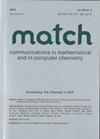分数阶延迟糖酵解振荡模型分岔的探索与控制
IF 2.4
2区 化学
Q2 CHEMISTRY, MULTIDISCIPLINARY
Match-Communications in Mathematical and in Computer Chemistry
Pub Date : 2023-01-01
DOI:10.46793/match.90-1.103l
引用次数: 0
摘要
近年来,建立适当的动力学模型来描述不同化学物质之间的关系已成为化学领域的一个重要主题。本文建立了一个分数阶延迟糖酵解振荡模型。利用收缩映射定理,探讨了一类具有时滞的分数阶糖酵解振荡模型解的存在唯一性。利用适当的分析技巧,讨论了已建立的分数阶糖酵解振荡系统溶液的非负性。利用一个合适的函数,研究了分数阶糖酵解振荡系统的有界性。利用分数阶动力系统的稳定性和分岔理论,研究了具有时滞的分数阶糖酵解振荡系统的稳定性和Hopf分岔的产生。利用延迟反馈控制器和pd - α控制器,研究了分数阶糖酵解振荡系统的Hopf分岔控制问题。计算机仿真结果支持所得结论。所得结果对控制不同化学成分的浓度具有重要的理论价值。本文章由计算机程序翻译,如有差异,请以英文原文为准。
Exploration and Control of Bifurcation in a Fractional-Order Delayed Glycolytic Oscillator Model
Recently, establishing proper dynamical models to describe the relationship among different chemical substances has become a vital theme in chemistry. In this present article, we set up a new fractional-order delayed glycolytic oscillator model. Utilizing the contraction mapping theorem, we explore the existence and uniqueness of the solution to the involved fractional glycolytic oscillator model with delay. By virtue of some suitable analytical skills, we discuss the non-negativeness of the solution to the established fractional glycolytic oscillator system. Taking advantage of a suitable function, we investigate the boundedness of the fractional glycolytic oscillator system. Exploiting the stability and bifurcation theory of fractional dynamical system, we study the stability and the generation of Hopf bifurcation of the fractional glycolytic oscillator system with delay. Making use of delayed feedback controller and PDα controller, we deal with the Hopf bifurcation control of the fractional glycolytic oscillator system owing delay. Computer simulation results are displayed to support the obtained assertions. The acquired results of this article own great theoretical value in dominating the concentrations of different chemical compositions.
求助全文
通过发布文献求助,成功后即可免费获取论文全文。
去求助
来源期刊
CiteScore
4.40
自引率
26.90%
发文量
71
审稿时长
2 months
期刊介绍:
MATCH Communications in Mathematical and in Computer Chemistry publishes papers of original research as well as reviews on chemically important mathematical results and non-routine applications of mathematical techniques to chemical problems. A paper acceptable for publication must contain non-trivial mathematics or communicate non-routine computer-based procedures AND have a clear connection to chemistry. Papers are published without any processing or publication charge.

 求助内容:
求助内容: 应助结果提醒方式:
应助结果提醒方式:


